Why is it important to have scheduled mealtimes for cats? It is essential to have scheduled mealtimes for your cats not only for you to control their weight and the amount they eat but also to control their energy levels. Cats are creatures of habit, and by controlling when they eat, cat owners are better able to control their activity levels throughout the day.
The Importance of Scheduled Mealtimes for Cats
Many believe that you can’t control a cat or get them to do what you want. However, maintain their food and environment, you’re able to control their behaviors indirectly. In conjunction with play therapy, we owners can manage our cat’s activity levels to match our activity levels and lifestyle.
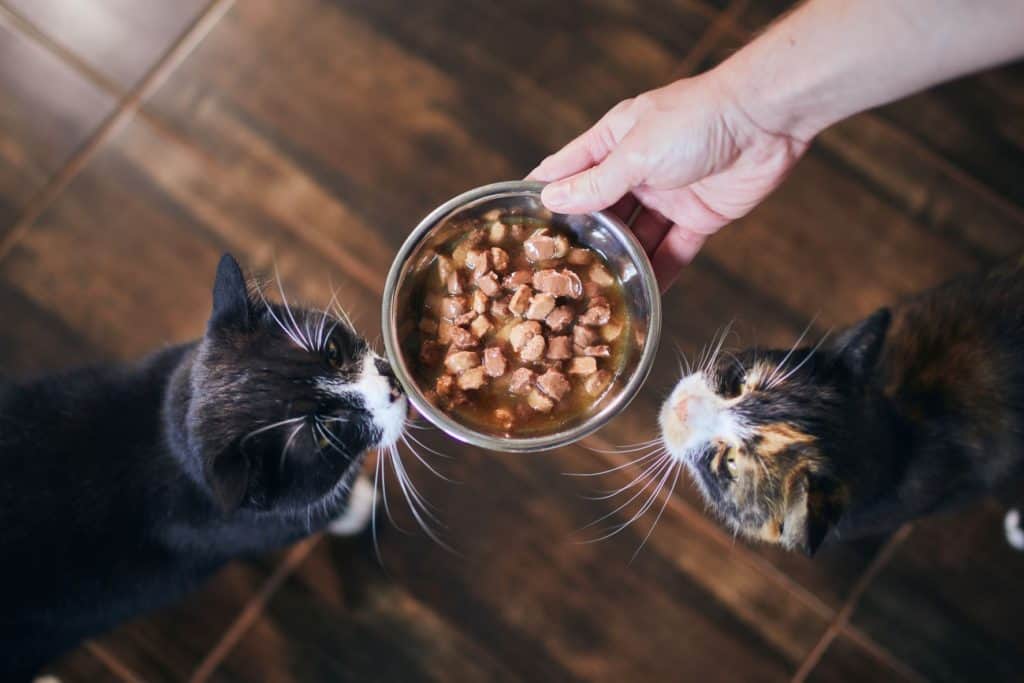
This might not seem like a big deal at first, but when your cats start playing in the middle of the night, it might become a big deal. Or, if your cat becomes lazy and overweight, their health becomes a big point of concern.
In my small studio apartment, this matters a lot. There is no way to separate me and my cats. Meaning if sleep was important to me, I had to figure out a way to control their activity levels at night time. I mean, I love having active cats, but I want them to be active when I am active and not when I’m sleeping.
Why Have Scheduled Mealtime For Cats?
So why does having a scheduled feeding routine help with their energy levels? It comes back to instincts and a cat’s natural behavior. Cats in the wild will hunt or forage for themselves whenever they need to eat. As such, the act of eating is very much linked to energy levels. When cats finish catching and eating their prey, they’re super exhausted.
What does anybody do when they’re exhausted and full? They sleep. Cats do this to conserve energy for their next hunt. Domestic or housecats obviously don’t hunt for their food, but those instincts are still there. After cats eat and groom themselves, they’re likely to go into a low-energy state or be quite lethargic.
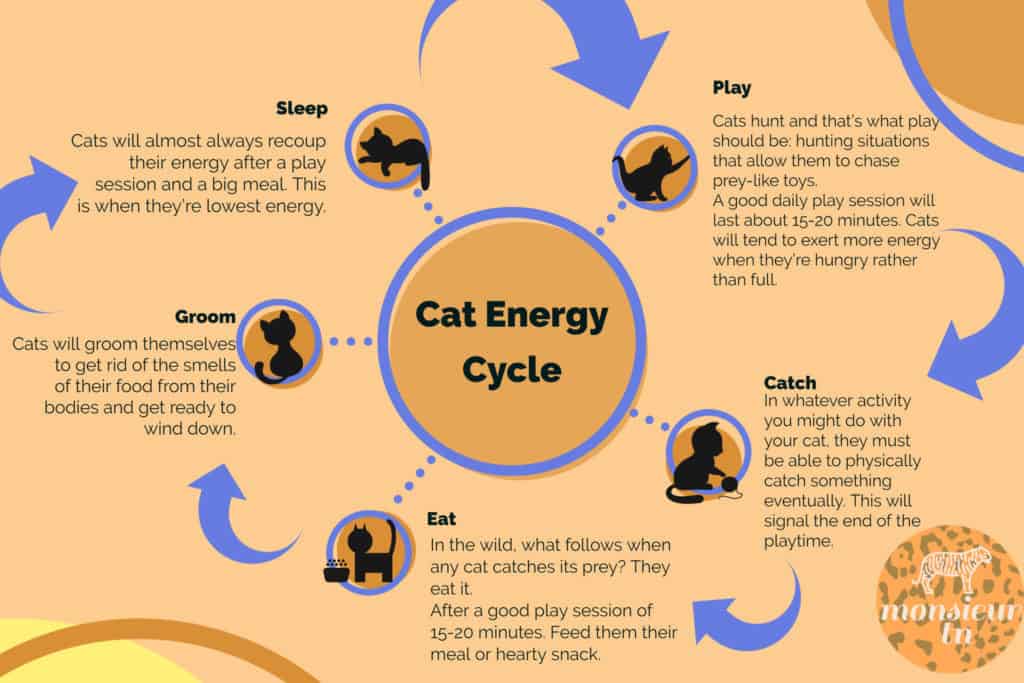
Now to go a step further, if you combine both play and mealtime after a play session, this effect is even more substantial. So, when a cat eats a big meal, you can expect them to follow it up with a nice nap. Like a real wild cat, they complete the whole process of hunting, catching, and then eating indoors.
What Are The Effects of Scheduled Meal Times?
The most direct effect will be a controlled diet. They won’t be continuously eating throughout the day, which will likely positively impact their weight (if you’re looking for your cat to lose weight). A cat not eating all the time is a busy cat.
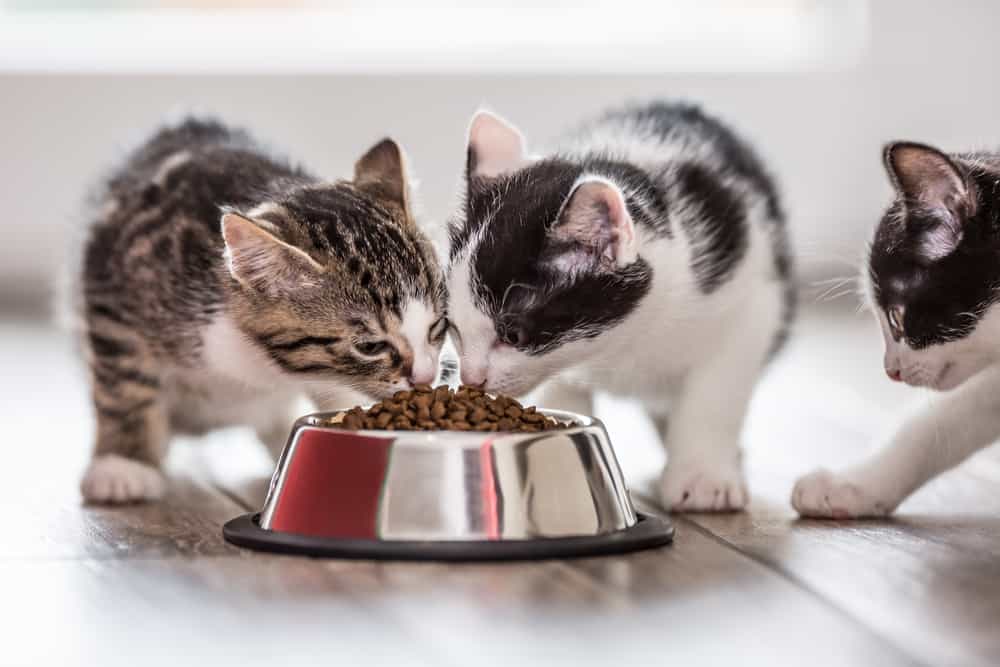
So how will this newfound knowledge help you influence your cat’s behaviors?
- Feed them right before a time that you need downtime or silence. They will become lethargic and probably be down for the count especially if you have played with them beforehand (the effect is much more pronounced if you have played with them for at least 15-30 minutes!).
- Another great benefit of scheduled feeding is the positive associations created during mealtime. As most cats are highly food motivated, with each mealtime, you strengthen the bond between you and your cats. Also, they can also strengthen the bond between their cat roommates too!
- It’s a powerful tool that I have consistently used for introducing any new kitten or cat. It’s what has allowed me to introduce them without having a long insolation process.
How Much Should I Feed My Cats?
Each bag of food or brand will have a label that appropriately gives cat owners a good first reference guide on how much to portion for your cats. Check your cat’s weight and try your best to get as close as possible to the recommended guidelines.
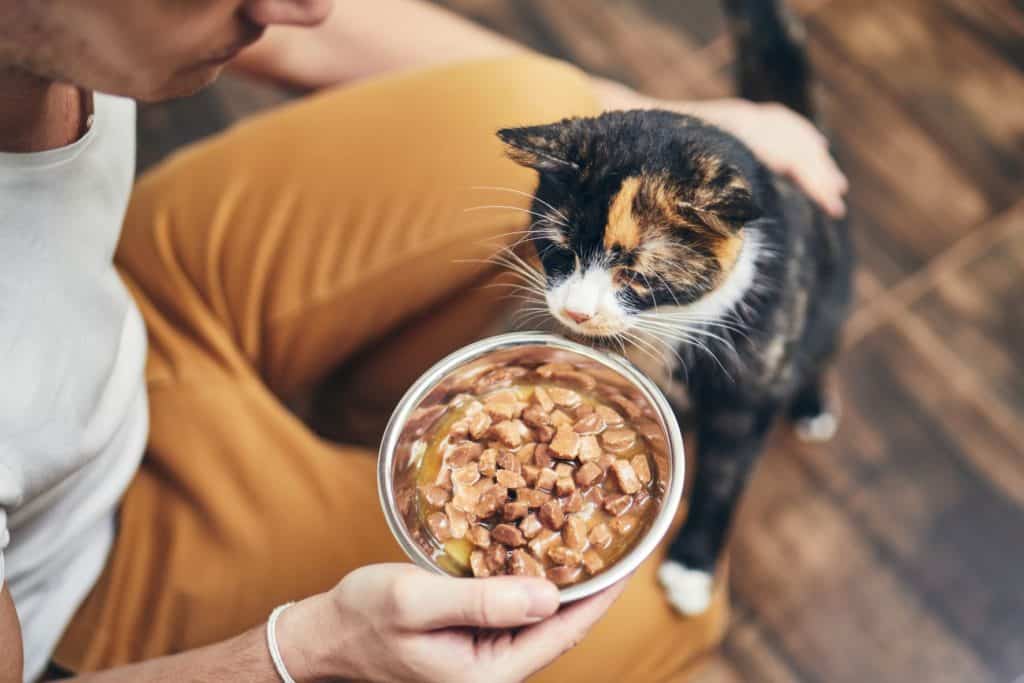
- Start with the recommended portion and observe how fast your cats finishes the food (a clean plate).
- In general, they should finish their food completely before their next mealtimes. If there’s still food in the bowl when it’s their next mealtime, slowly start to decrease it until they do.
- According to Petmd.com, Every one or two weeks, assess or reasess your cat’s body and readjust their portions accordingly (it’s always a good idea to have a record of your cat’s weight).
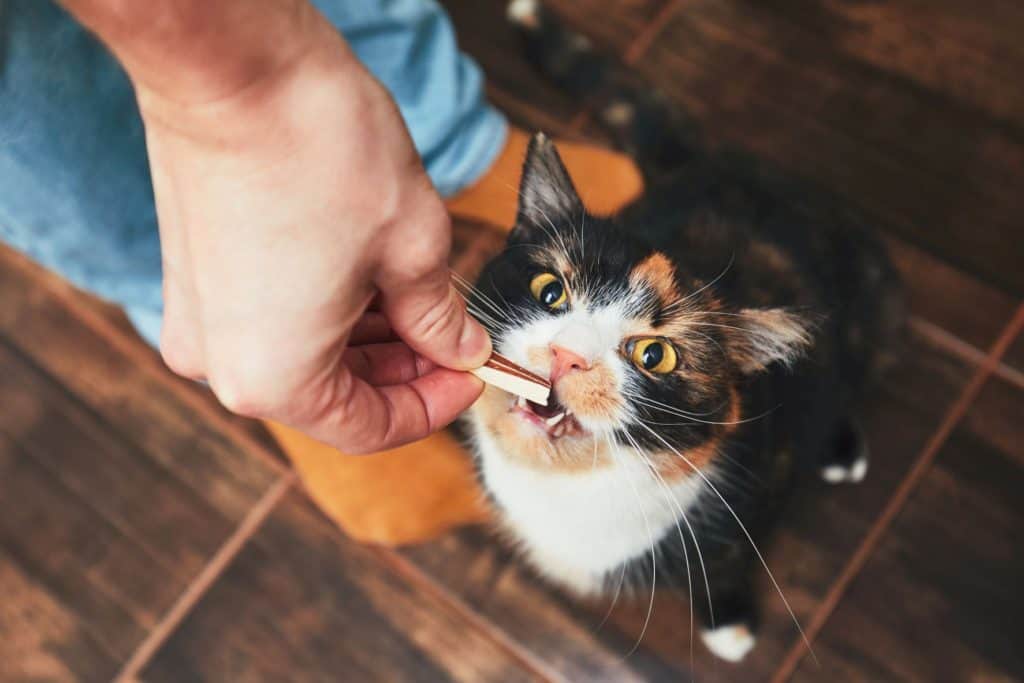
I always give my cats enough food so that once an hour or two has passed, they will finish the whole bowl or plate. As a result, by the next mealtime, they’re hungry enough for the next portion.
If your cats are not finishing the food in time, leave it until they finish and give them their next meal a couple of hours later (maybe after a play session). That way, they’re expecting food and begin to cultivate the habit.
When Is The Most Optimal Feeding Times For Cats?
Two main feeding schedules are most commonly employed by cat owners that have jobs (which is most people):
- Three medium sized meals a day
- Two large meals a day
These are by no means the only two feeding regimens. Create the schedule that best fits your schedule and the ways that your cats like to eat! The key is to stay consistent so that your cat(s) has time to adapt and change its inner clock.
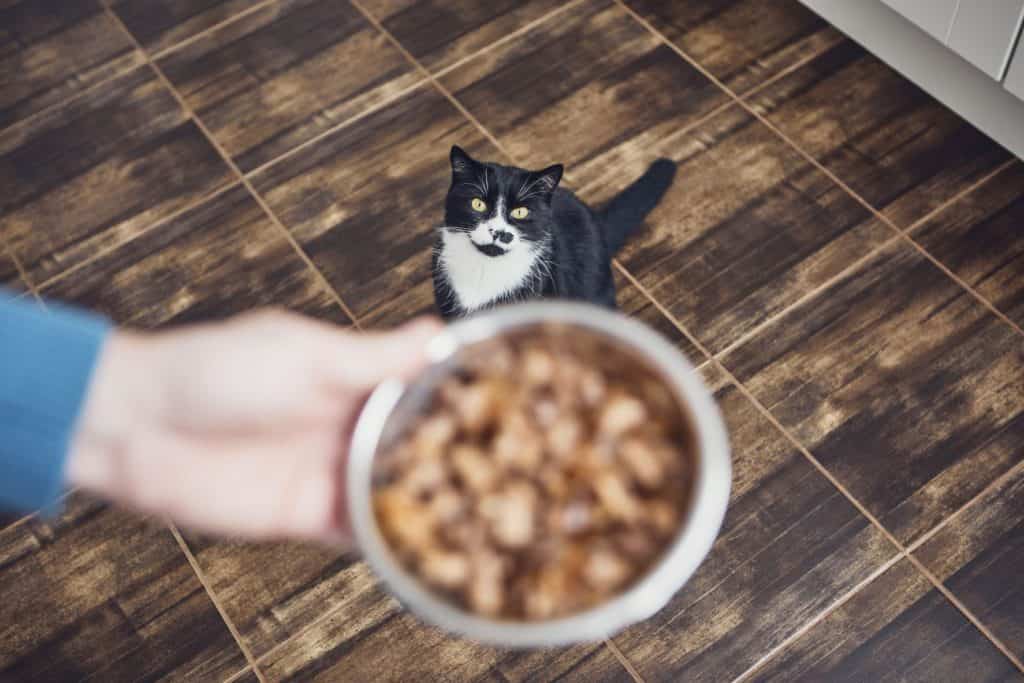
Cat Feeding Schedule 1: Three Medium Sized Meals a Day
This is the feeding schedule that I use for my cats right now, and it’s been working well for their daily routine. I am a regular person, meaning I go to work in the morning and come home in the evening. So my schedule is likely to be similar to most people as well.
First Meal: Morning (Before Work)
Mornings are pretty chilled for cats, and they tend to lounge around. So to make sure they have enough food before I go to work, I give them a little more food for their first mealtime as the gap between breakfast and the next mealtime is quite large.
They’re all so used to it by now, as the moment I step out of the bathroom is when they’ll start meowing at me to give them their breakfast! Since I’ll be away for quite a while because of work, I’ll take out some of their favorite toys for them to expend some energy in the daytime.
Second Meal: Evening (After Work)
Cats will start to get hungry after this time. Giving them a smaller meal is recommended to tide them over until dinner. This is the time when their energy picks up because I’m at home. They’ll be wanting a lot of my attention. Therefore, I leave most of their toys and cat stuff out, so the cats can still play around.
Third Meal: Night (Before Bed)
Before their last meal, I give the cats a bit of interactive playtime for them to expend the last of their energy and be ready for the final feast of the day. After that, I put away their toys, loose items, and anything they might be wanting to play with so that they’re all ready for a long night’s rest.
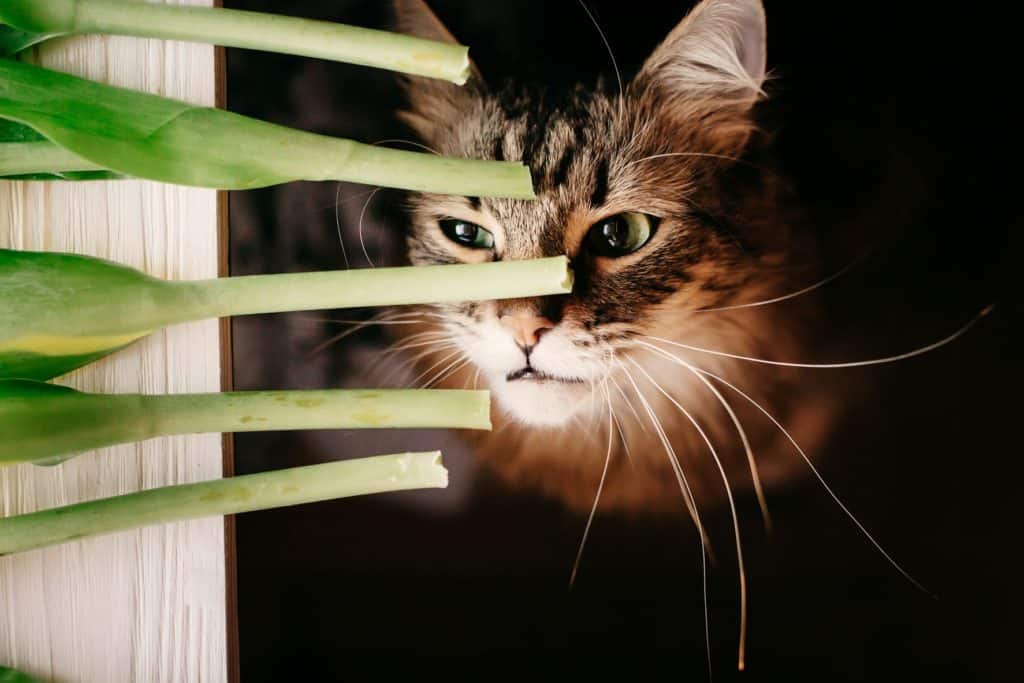
Cat Feeding Schedule 2: Two Large Meals a Day
Cats engage in intermittent fasting all the time in the wild. Therefore, there are periods in which they don’t have any food. This is the schedule likely for people working longer hours and can’t be home often to feed their cats. It’s still an effective feeding schedule as it caters to the cat’s natural being.
First Meal: Morning (Before Work)
Nothing is changed here except portions. Because you’re going to feed them less frequently, portion out more food to last them until their second big meal. This means that instead of having them finish a meal within one to two hours. Try to give them enough to finish their meals within two to three hours after being put out.
Second Meal: Night (Before Bed)
Providing another large meal before you go to bed will allow cats to feel full and satisfied to recoup their energy for the next day. Again, put away the stuff you don’t want the cats to interact with at night to reinforce further that nighttime is a time for rest and not play.
What Happens If I Allow My Cats To Free Feed?
The dangers of free-feeding are pretty well-documented, from obesity to urinary problems or even worse. This is because every time a cat eats, its insulin level spikes, and the cat’s body cannot handle that for an extended period. Most of the time, this develops into diabetes.
If you’re free-feeding a cat, it is also challenging to discover problems or health issues that your cat might have. For example, if you have mealtimes, you can see clearly who is eating and who is not. A healthy cat is a cat that eats well (at the proper time), but if you’re free-feeding, how do you know if a cat isn’t eating or is overeating? It isn’t easy to tell.
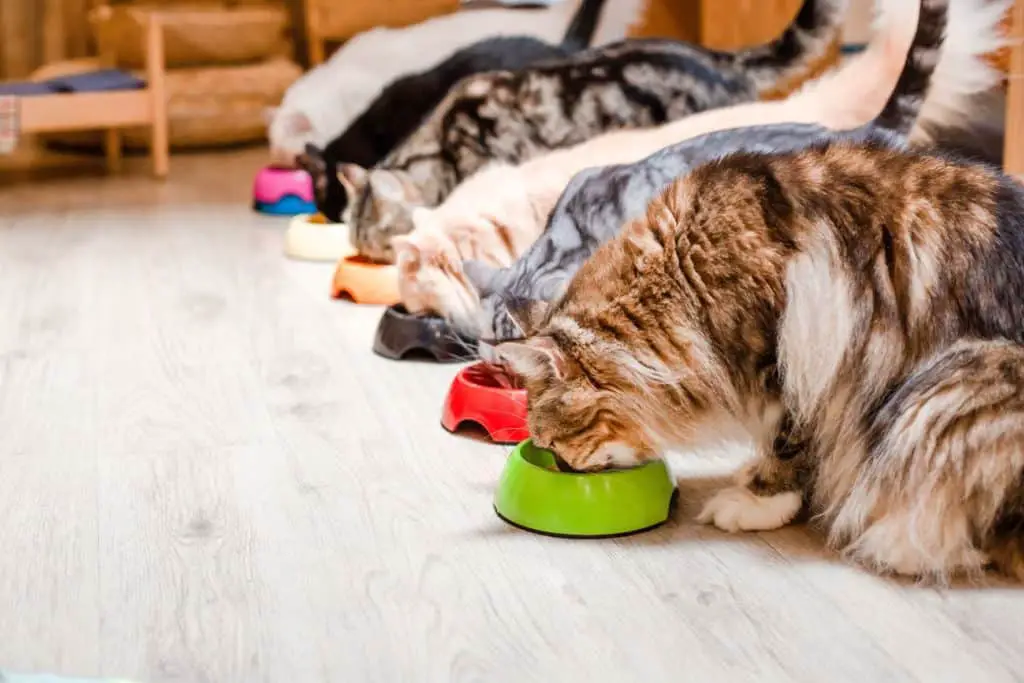
Another reason you might not want to free feed is, in a multi-cat home, if one cat eats at a different rate than the others. One cat could eat most of it at first, and then when a different cat gets hungry, maybe there’s only a little bit of the food left. By having a specific feeding time, cat owners can make sure all cats eat simultaneously and in similar amounts.
What Do I Feed My Cats?
Cats are, of course, obligate carnivores. Obligate carnivores mean that they must eat meat. The higher the amount of protein that is in their food, the better. In the wild, cats would catch their food and eat it raw, cartilage, organs, and all. The closer we can get to this origin, the better for our cats.
I wholeheartedly believe that raw is best for our cats; however, feeding them raw is usually difficult, depending on your situation. Sometimes, I will take a trip on the weekend to the butcher’s and ask for some of the cheap raw trimmings for my cats. They love it, but it’s not an everyday type of thing. However, it’s something that I want to improve in the future.
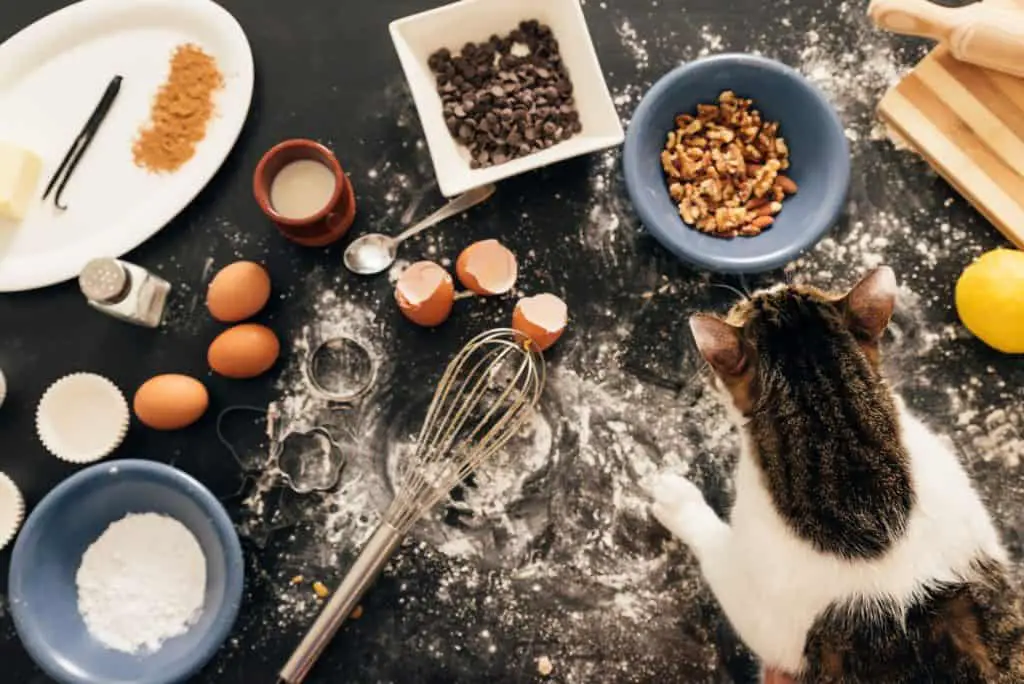
Day-to-day, however, I opt for high protein content, grain-free dry food. It’s easy to portion and measure and highly convenient because it’s preparation-free. My Bengal cat is quite sensitive and will have diarrhea if his food is not grain-free.
I try to do the best I can for my cats within my means. Your situation might be different.
Scheduled Feeding Times For Cats: Conclusion
Having a scheduled time in which cats feed is one of the most important decisions you can make for your cat(s). For benefits beyond just weight and health, cats can benefit a lot from positive and consistent habits.

Any advice for moving away from free feeding when you are also worried about picky eaters? I’ve gotten in the habit of free-feeding dry cat food because my cats would actually eat it, even though I know they should be on wet food. I would try all these different kinds of wet food, put some out and maybe two bites would be eaten, and the rest totally untouched. I couldn’t save the rest in the fridge and put more out later, because it would go completely untouched. And I know that going even a couple of days without eating can throw a cat into serious metabolic problems. So what do I do?
It’s okay to give them dry food meals during mealtimes!
Dry food is not inherently bad but it does cause our cats to be a bit too dehydrated which is why wet food is a bit better.
If you DO want to start switching from dry to wet food. I would go slowly by mixing some wet with the dry food! And slowly decrease the amount of dry food available every day.
Gradual changes rather than sudden changes are the key here!
I was told to feed my kitten wet food on a schedule and free food the kibble until she’s a year old. I buy high quality grain free high protein. She is very active and in large part Begal. Do you agree with this?
If your Cat is a Bengal – they tend to have quite sensitive stomaches in their early kitten days, therefore more likely to have diarrhea. However, I didn’t wait a year – a switched my Bengal kitten pretty soon to grain free protein pretty soon after adopting him.
If your kitten is healthy and doesn’t have pooping issues – I don’t see why it’s a problem. Go with what works and keep your cat healthy!
Hey,
First of all I love you channel! Very informative and helpful videos!
Not sure if you have mentioned it somewhere, but would you be able to say more or less how many grams per day do you feed your cats?
I’ve adopted a tabby female cat, Tiga, she’s gonna be 7 years old in one month and she’s not very active, but we do play 45 min total during the day in order to release her energy a bit. We don’t have much space in our flat as we share rooms with other people, so most of the days she’s in our room. She’s not using cat tree or any higher points of the room but she has just recovered from fractured pelvis and I believe that is the reason, she’s simply afraid. But I do struggle to find out how much should I feed her, don’t want her to get fat. Got her a Catit food tower – she’s not interested.
It’s the first time I own an animal and I do wanna keep her healthy. Any advice would be much appreciated! Thank you!
I think you’ll be able to figure it out as time goes by! Just take note of how much food she leaves after a scheduled mealtime. If it’s a lot – decrease the food. A good rule of thumb is that they should finish within about an hour of feeding. If there’s too much food left after an hour – it’s generally too much. Decrease the amount of food you give her next time. About the food tower – use it exclusively during meal times and see how she reacts. Don’t worry if she seems disinterested. IF that’s where the food is, she has no choice but to interact with it! Keep consistent!
Thanks for your comment.
Hi! In one of your more recent posts you mentioned you’re now on a 2 meal per day schedule. What times are you giving the meals now and how much per meal?
Yes! I moved from 3 meals to 2 meals. Basically, the total amount of food is the same. So instead of 3 moderately sized meals – it’s 2 quite big meals. One big one in the morning when I get up and one big one at night before I sleep.
I recently welcomed a Russian Blue kitten into my home. She’s adorable but also a handful! Relevant to this article, I’m trying to put her on a meal schedule of 2 meals a day, but she would leave more than half of her food after a meal. I’m feeding her kibble portioned based on her weight so it seems like she’s not eating enough for her weight- even if I leave the food out overnight she doesn’t finish it by the morning. I end up just leaving her leftover kibble there throughout the day since she’s not finishing it. Any tips on how to implement a meal schedule and make sure she finishes her food? Thanks!!
What I like to do when my cats can’t finish a meal is by having either having those powder supplements that adds flavor/different smell along with other nutritional benefits to their dry food! Just sprinkle it on and see how she likes it! Cats like variety in their foods. The same kibble every day can be boring, especially for picky eaters (like Russian Blues). There’s a lot of products out there, this is one for example (link to amazon). You might have to experiment with the flavor/supplement she likes most!
My partner and I moved in together and we both have cats. His are on a strict 2x/day feeding schedule, and they gobble up their food in one sitting. My cat is also on a schedule but he never finishes his food right away, and comes back to it after a few hours. The problem now is that when he doesn’t finish it…..one of the other cats comes and finishes it for him, so then that cat is eating too much and my cat isn’t eating enough. My partner thinks I should train my cat to eat all of his food in one sitting by only leaving it out for 30 min and then taking it away until next mealtime 12 hours later, but that doesn’t sit well with me, because don’t cats have tiny stomachs and it’s normal for them to eat several small meals in a day?